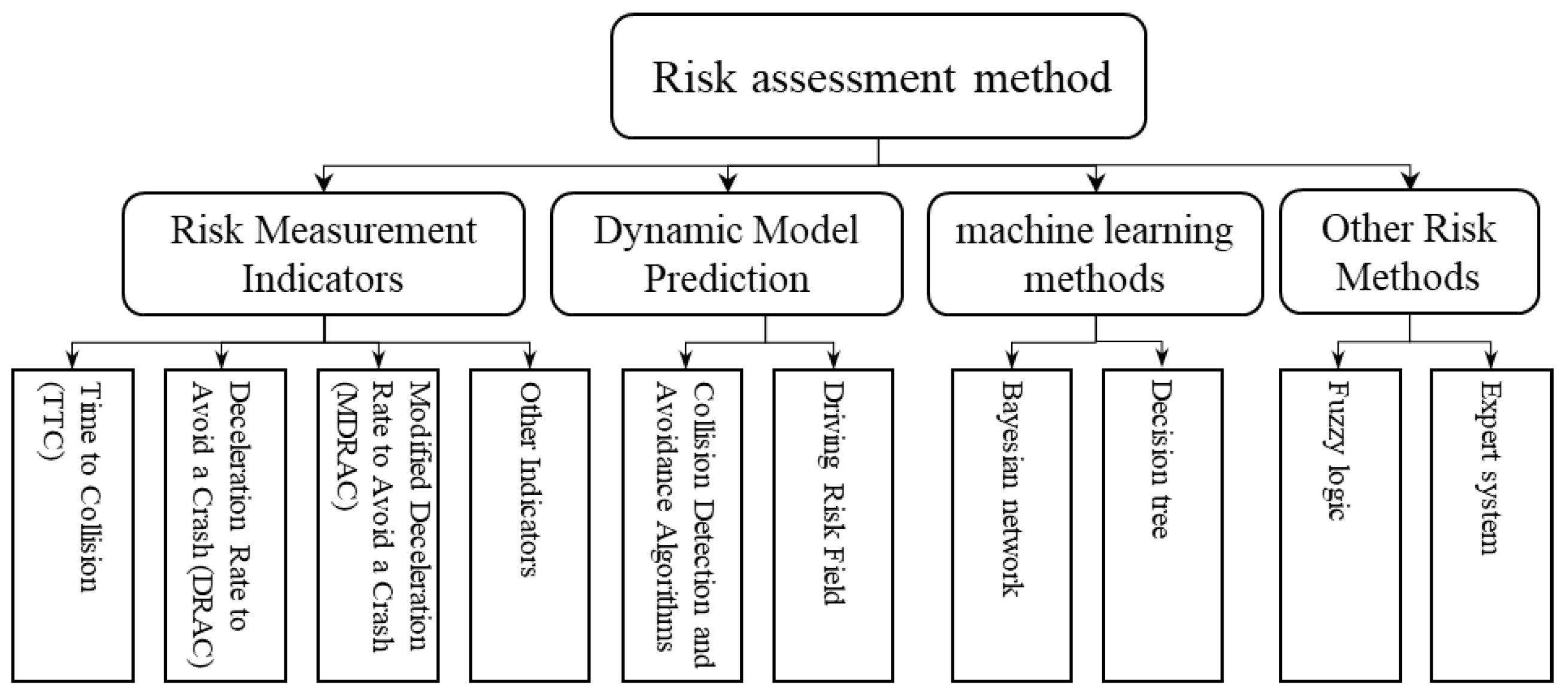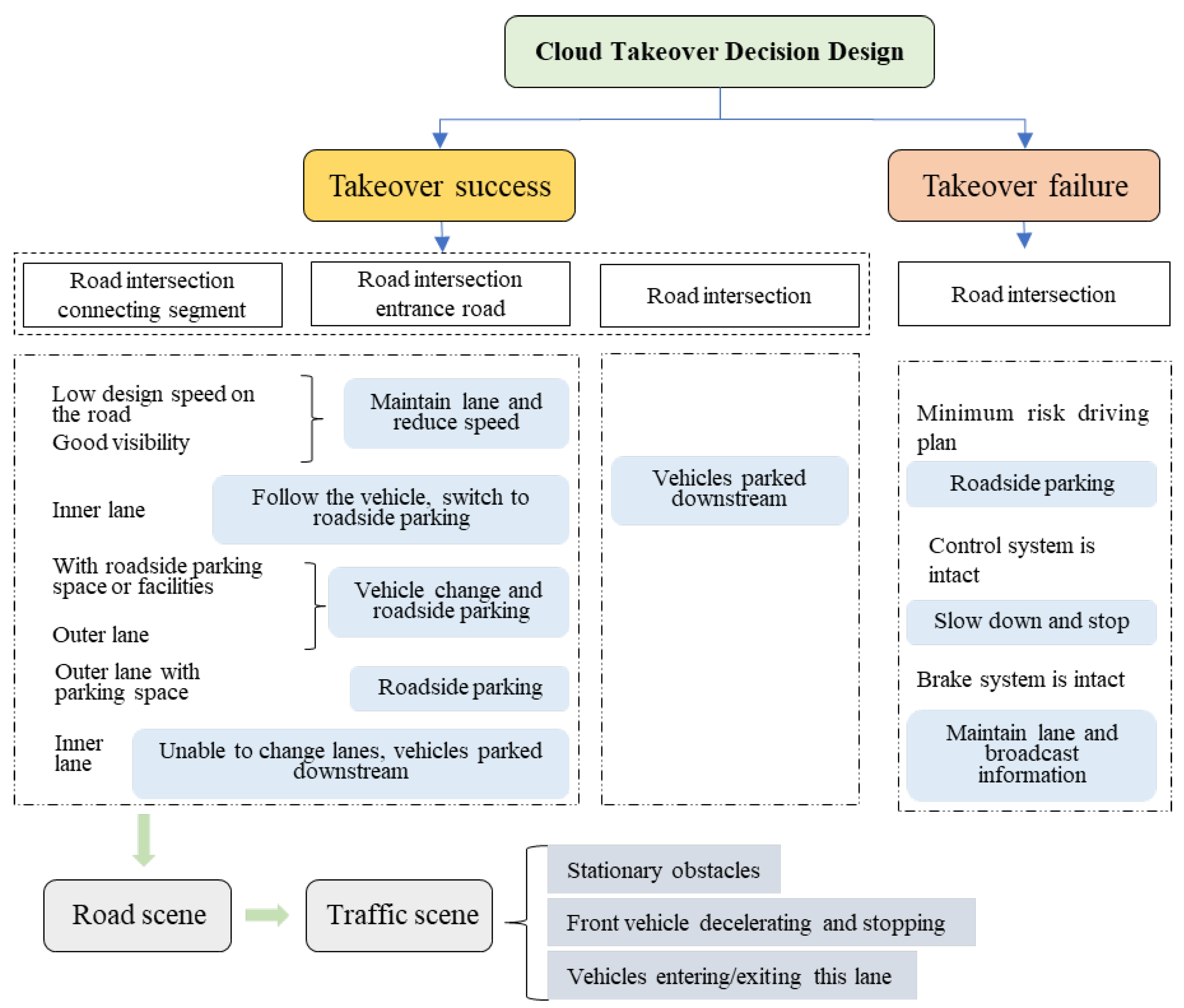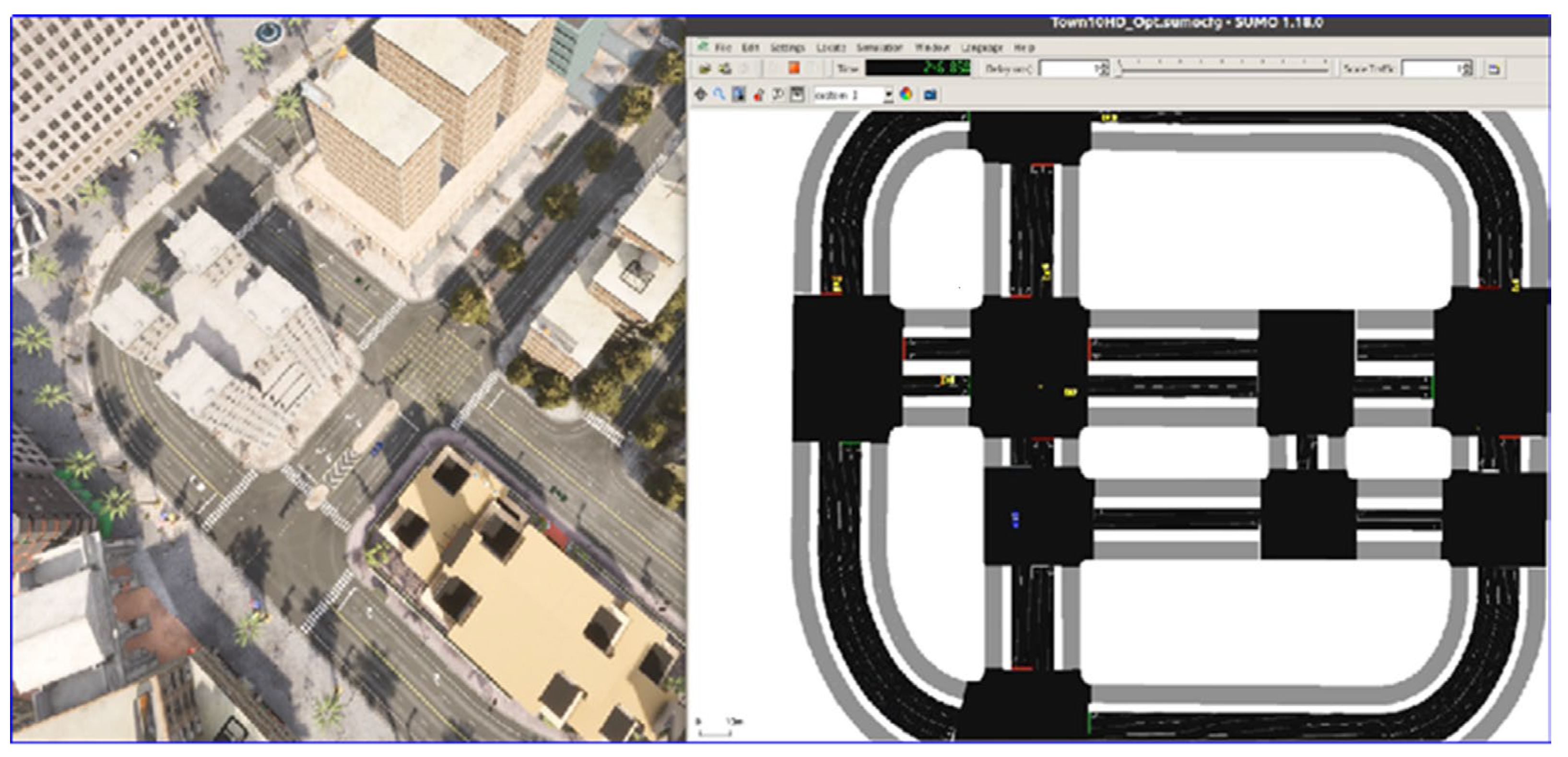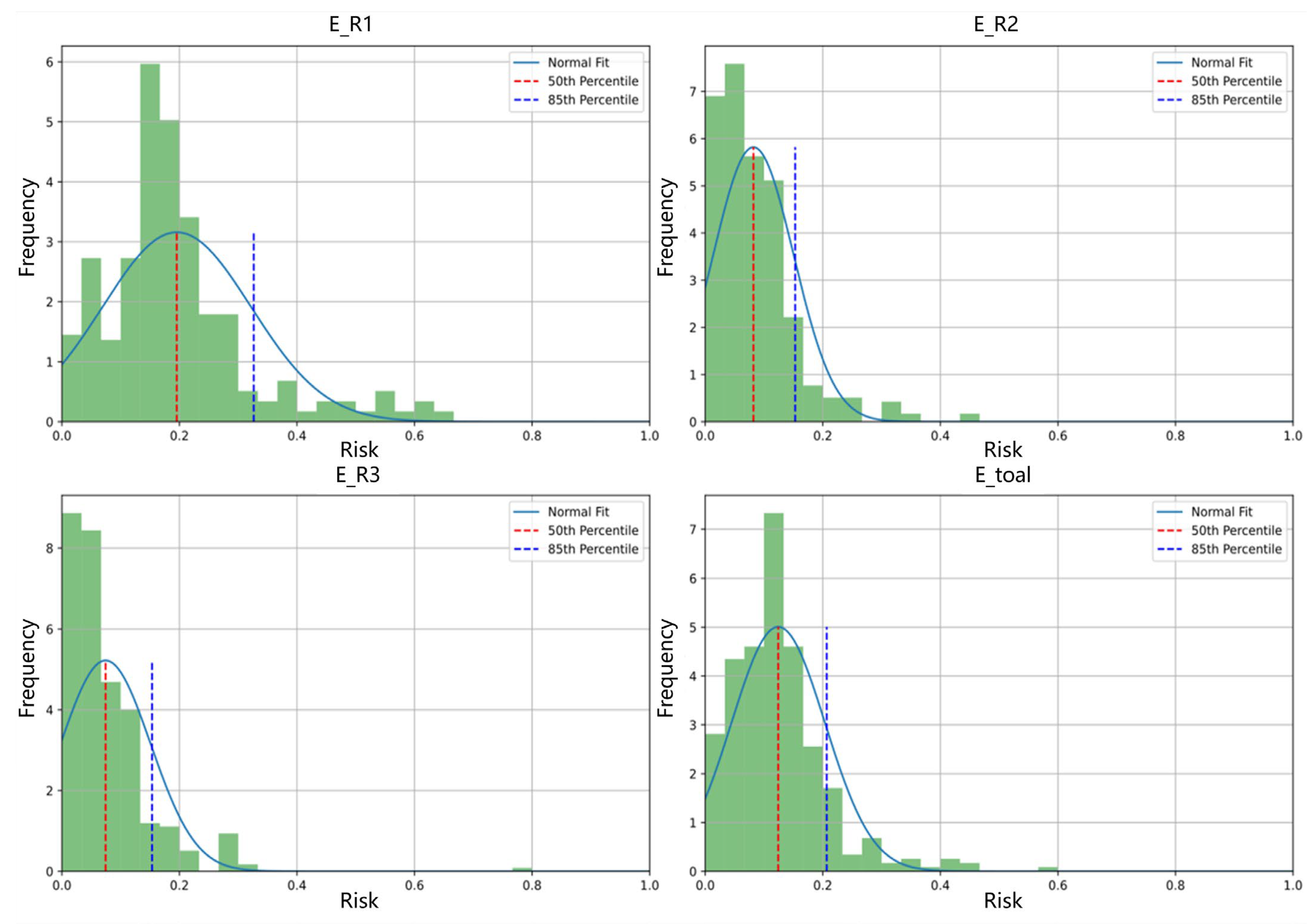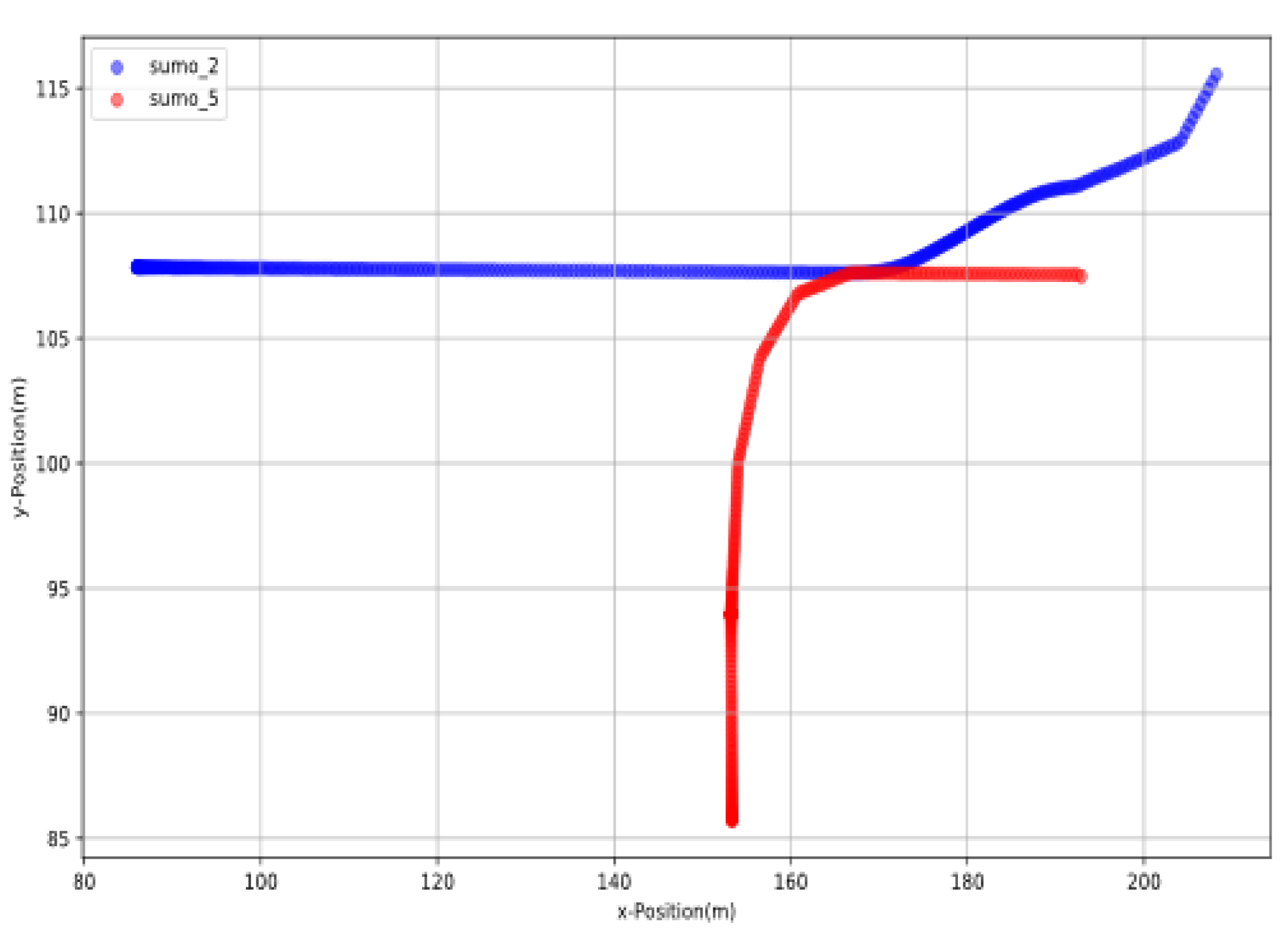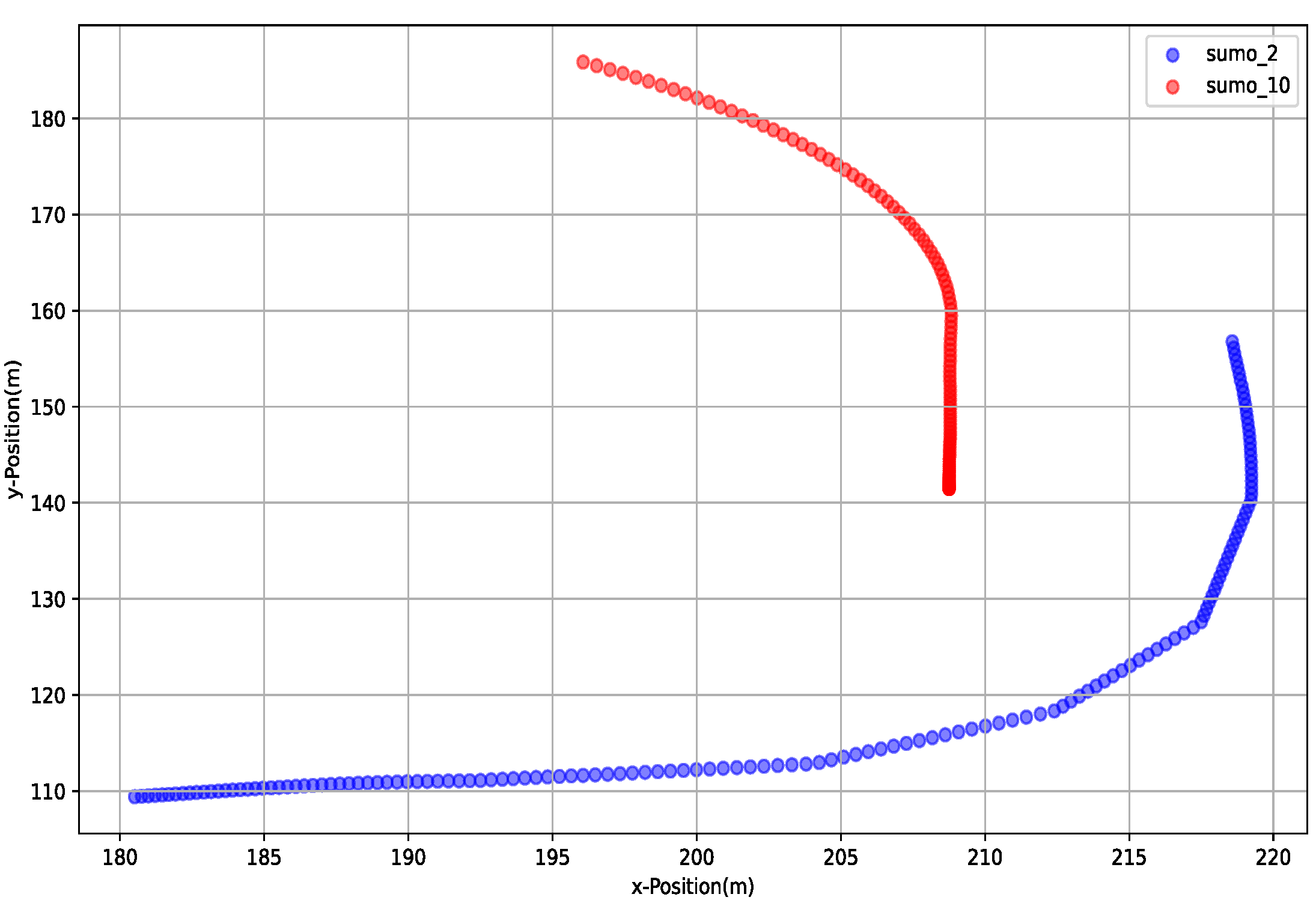2. Related Work
Scholars have conducted some research on the quantitative analysis of driving risks in autonomous vehicles. Risk quantification in driving often employs methods such as statistics and mathematical models to transform risks into measurable indicators or values. A key focus of risk quantification research is how to establish the mapping relationship between environmental variables and driving risks.
Noh S et al. proposed a risk assessment framework suitable for urban autonomous driving, which identifies risks through long-term motion prediction and evaluates the likelihood of collisions using a unified risk measurement and probabilistic risk reasoning within a distributed reasoning architecture [
2]. Pang et al. proposed an assessment framework that can predict and evaluate the likelihood of collisions in urban environments, taking into account factors such as road types, road attributes, and traffic regulations [
3]. HZ T et al. developed a safety risk assessment framework based on the probability and severity of potential autonomous vehicle accidents, providing preliminary safety risk assessments for road testing of autonomous vehicles, along with application cases from Shanghai and Gothenburg [
4]. Liu QC et al. studied the predictability of crash risk caused by manual takeover of autonomous vehicles in mixed traffic flow [
5]. Patel A et al. proposed a new method for identifying and classifying the severity and controllability levels of driving scenarios for autonomous vehicles, employing support vector machine learning techniques to train, test, and validate the model [
6]. Shetty A et al. presented a risk assessment framework that utilizes human driving data and road-testing data to evaluate the safety of autonomous vehicles, highlighting the differences in collision risks under various driving maneuvers and environmental conditions [
7]. In a complex traffic environment, by using reinforcement learning or Bayesian inference to conduct real-time identification of multiple risk factors, the collision avoidance performance of the system can be enhanced [
8,
9]. These papers cover multiple aspects of risk assessment for autonomous driving in urban environments, including collision risk prediction, occlusion perception, interactive perception models, and comprehensive risk assessment methods, providing effective strategies and approaches to improve the safety of urban autonomous driving.
Currently, there are mainly two approaches: the model-based method and the definition function method. The model-based method refers to using machine learning algorithms to learn driving data and construct nonlinear mapping models between environ-mental variables and driving risks. Common algorithms include support vector machines, decision trees, and neural networks. Fei Ma et al. proposed a framework for identifying road section accident risks at the granular level by utilizing traffic conflicts as an intermediary [
10]. Parsa, A. B. et al. used data-driven methods to characterize the model of the impact of autonomous vehicles on traffic flow and verified the effectiveness of the model with a large amount of data [
11]. Li Zhibin et al. [
12] proposed a rear-end collision risk prediction model based on aggregated traffic flow data, finding that the probability of rear-end collisions during the propagation of traffic waves is significantly correlated with the accident risk index and the standard deviation of upstream occupancy rates. This proves that the risk of rear-end collisions is highest when traffic transitions from free flow to congestion, and the propagation of traffic waves in congestion increases the risk of rear-end collisions. Hossain M et al. [
13] proposed a Bayesian framework for predicting collisions on congested urban expressways, which can predict risks 4–9 min into the future and validated the method’s effectiveness using real data. Wang et al. [
14] studied the application of potential field theory to analyze the risk changes that vehicles encounter under different traffic conditions. Wei et al. [
15] established a model for lane-changing behavior of connected autonomous vehicles based on the theory of risk potential field. Wang Qingbin et al. [
16] established a prediction model for ship accident risks and types based on an improved XGBoost algorithm, demonstrating significant improvements in model AUC values and prediction accuracy through experiments. Xie G et al. [
17] developed a risk model for autonomous vehicle merging based on decision trees and support vector machines, allowing intelligent vehicles to assess the risks posed by other vehicles during merging and their own risk assessment of following vehicles during the merging process. Pawar et al. [
18] used video detector data to reduce the operational risks of right-turning vehicles at signal-free intersections. Machine learning algorithms can reduce the impact of human subjective bias, helping to improve the objectivity of risk quantification [
19]; however, this method has high data requirements, and the interpretability of models and adaptability to different scenarios still need improvement. Zhu L et al. [
20] conducted in-depth research on the safety and efficiency of autonomous vehicles operating at the traffic bottleneck areas of highway ramps, focusing on the operation mechanism of autonomous vehicles in complex traffic environments. Jiang C et al. [
21] studied the risk assessment of operation safety for a new type of complex traffic flow (in which truck fleets equipped with (cooperative) adaptive cruise control devices) and traditional human-driven cars (HDCs) and trucks (HDTs) in various scenarios of port highways. By studying the characteristics of traffic flow congestion, the dynamic characteristics of phase transition are investigated, and the dynamic risk assessment among adjacent vehicles is carried out [
22,
23].
In contrast, the definition function method quantifies risks by defining a mapping function between environmental variables and driving safety, based on various foundational theories. This method has better interpretability, does not rely on large amounts of data, and offers high computational real-time performance. Ming Yue et al. constructed a model to quantify vehicle spatial collision risks by combining relative distance and relative angle, conducting a series of simulations in typical scenarios on the CarSim–Simulink joint simulation platform to validate the feasibility and effectiveness of the proposed shared steering control method [
24]. They quantified the driving risks caused by vehicle conflicts based on kinematic indicators and further achieved a more comprehensive and accurate risk assessment method for scene information using intelligent connected vehicles [
25]. They used dynamic indicators such as yaw rate and centroid side slip angle to quantify the risk of lateral instability in vehicles [
26]. Additionally, Wu Jian et al. [
27] studied the evaluation methods for driving risks, considering multiple factors involving people, vehicles, and roads, and analyzed the causes of traffic accidents and the mechanisms of their impact on driving risks. Wang et al. [
28] have developed a framework for decision-making and trajectory tracking for autonomous vehicles, providing a research foundation for the operation of vehicles at different levels of autonomy. Charly A. et al. established a methodology to identify risky driving behavior using driving performance measures [
29]. Wang J et al. [
30,
31] utilized field theory to represent risk factors caused by drivers, vehicles, road conditions, and other traffic factors, providing a new foundation for formulating driving safety measures and proactive vehicle control in complex traffic environments. Wang Y et al. [
32] proposed a decision-making planning method based on motivation and risk assessment, focusing on the decision-making behavior of human drivers. Wang Yuanyuan et al. [
33] introduced a risk potential cloud model addressing uncertainty, which effectively quantifies the danger level and occurrence probability of potential collisions, establishing high-risk sensitivity and probability sensitivity driving styles, thus providing more diversified and human-like intelligent decision-making and trajectory planning methods for autonomous vehicles under varying driving risk conditions. F.K. et al. [
34] primarily focused on fault detection and combinatorial coverage, considering the implementation of two types of automatic emergency braking functions. During the driving on curved sections, the quantitative representation of vehicle trajectory deviation is the core of safety assessment [
35,
36,
37]. Large language models and artificial intelligence technologies have been utilized to study the quantification of collision risks for autonomous vehicles [
38,
39].
In summary, existing risk assessment methods still face the following key challenges in complex urban road environments: (1) Single dimension of risk and insufficient com-prehensive quantification: most methods, whether model-based or function definition-based, focus on assessing specific types of risk (such as collision risk or instability risk) or target specific scenarios (such as cut-in or car-following). In the complex mixed urban traffic flow (including vehicles, pedestrians, non-motorized vehicles, etc.), risks are multidimensional (collision risk, lateral instability risk, traffic rule violation risk, traffic efficiency loss risk, etc.) and multi-sourced (own vehicle state, surrounding dynamic target behaviors, static road environment, traffic rule constraints, etc.). There is an urgent need for a unified framework capable of quantifying multiple risk dimensions comprehensively. (2) The generality of the assessment subject needs improvement: current risk assessment systems mainly design around single vehicles. With the development of vehicle platoon cooperative control technology, the importance of assessing the overall operational safety of platoons and the cooperative interaction risks among internal vehicles is increasingly prominent. Currently, there is a lack of unified assessment methods that effectively cover the risks of both single vehicles and platoons. (3) Lack of a closed-loop mechanism for real-time decision support under complex and variable environments: the ultimate goal of risk assessment is to guide safe and efficient decision-making. Existing research mostly focuses on risk quantification itself or uses it as input within specific control algorithms but lacks a tightly coupled closed-loop design that integrates multidimensional, dynamic risk assessment results with real-time, robust control strategy generation, especially when responding to differentiated traffic behavior patterns and sudden changes in complex environments.
